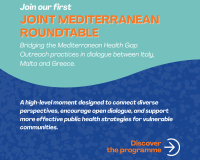Italy, Malta, and Greece are three Mediterranean countries with different approaches to tuberculosis (TB) incidence. In Italy, the TB incidence rate decreased on average by 2.8% per year from 2015 to 2019, and 56.2% of total cases reported occurred in persons of foreign origin. Italy is also the only country among the EU/EEA countries that has reported a higher frequency of new cases of TB among females than males. Malta is a low TB incidence country, but following the recent wave of immigration from the African subcontinent since 2002, an increasing number and proportion of TB cases were being detected among immigrants. In Greece, the most recent epidemiological data on TB collected annually through the mandatory notification system of the Hellenic Center for Disease Control and Prevention (HCCDP), concerns the years 2004-2010, that is prior to the recent refugee crisis in 2015. The report shows that during 2004-2010, an average of 600 cases were reported each year, with the reported cases of migrants increasing. The average incidence rate was higher in Central Greece and Attica (including Athens and Piraeus cities).
New strategies are required to improve early diagnosis and to make more people aware of their infection by expanding diversified and user-friendly approaches to more widely available HIV/STIs testing. The World Health Organization (WHO) has produced consolidated guidelines on HIV testing services, including guidelines on HIV self-testing and partner notification, and the European Centre for Disease Prevention and Control (ECDC) has published public health guidance on an integrated approach to HIV and hepatitis B and C testing. These recommend innovative approaches, including self-testing and community testing by lay providers using rapid tests as part of overall HIV testing services. Rapid scale-up of HIV testing is of the utmost importance, given the negative impact of the COVID-19 pandemic on testing.






